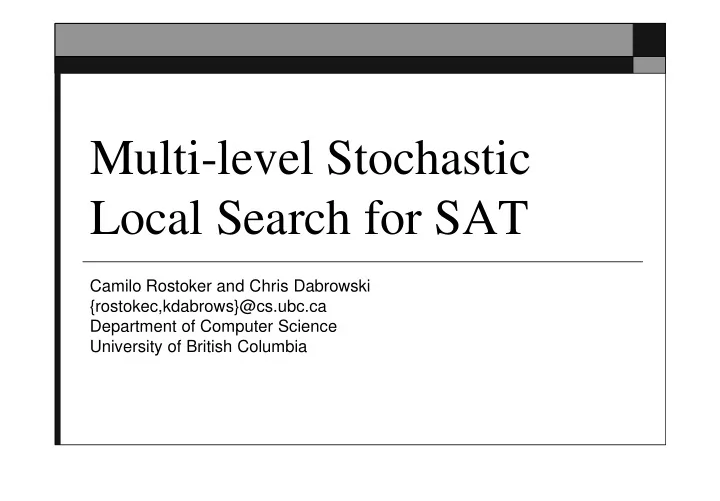

Multi-level Stochastic Local Search for SAT Camilo Rostoker and Chris Dabrowski {rostokec,kdabrows}@cs.ubc.ca Department of Computer Science University of British Columbia
Outline Introduction to SAT 1. Systematic vs. Stochastic Local Search 2. Hybrid & Multi-level Methods 3. Our Proposed Algorithm 4. Testing & Evaluation 5. Future Work and Improvements 6. Conclusion 7.
Satisfiability (SAT) � SAT problems are a fundamental problem in combinatorial optimization � Applications in planning, scheduling, circuit verification, economics, etc � Two approaches to solving problems � Systematic (Complete) � Stochastic Local Search (Incomplete)
Systemic SAT Methods � Systematic, exhaustive methods guaranteed to find a solution in bounded time (if a solution exists) � Most state-of-the-art complete methods based on David-Putnam-Logemann-Loveland (DPLL) procedure � Good for smaller SAT problems, mission-critical applications, or when time/resources is not an issue � Proven to be extremely effective for structured instances
Stochastic Local Search Methods � Incomplete, approximate search methods � Probabilistically Approximately Complete (PAC) � Trades guarantee of finding optimal solution for efficiency and scalability � General approach: Explore search space by iteratively perturbing a candidate solution using a given heuristic � Proven to be extremely effective for large, random, non-structured instances
Hybrid Methods � Combine systematic with SLS to get the best of both worlds � Benefit from systematic handling of structured instances while retaining scalability of SLS methods � Problem: How to determine how much relative amount of time/effort on systematic and SLS
Multi-level Methods Perform search on various “levels”, where a level � corresponds to assigning a subset of variables When the systematic search reaches a given level, let � underlying SLS procedure take control Same Problem: Do we spend more time performing the � systematic search or more time focusing in on a specific sub- region (SLS)? Existing multi-level methods try different combinations of � systematic & SLS searches Constrained Local Search (CLS): Randomized backtracking � WalkSatz: Satz, then WalkSAT on equivalence graph � Multi-level Cooperative Search: agents search different regions �
MLSLS for SAT Overview A hybrid approach to SAT that iteratively performs systematic � search guided by Satz look-ahead heuristic followed by a Novelty+ SLS procedure The amount of work to be done in the systematic stage is � referred to as the “level” search tree context � we “drill down” to a given depth in the search � tree search space context � we “freeze” a subset of the variables � The purpose of the systematic procedure is to exploit the � structure and variable dependencies, as well as reduce search space
High-level Pseudo-code
Key Points Variable subset selection and ordering is done by a Satz look- � ahead procedure, a variation of MOM’s heuristic The level can be dynamically adjusted every iteration � After the systematic procedure has set level variables, use � construction heuristic to get initial candidate solution Novelty+ then takes over and performs up to maxRunSteps � steps Novelty+ procedure is essentially the same except “frozen” � variables must be excluded
Variable Set Selection and Ordering � PROPz heuristic selects a set of variables � based on idea of MOM’s heuristic - Maximum Occurrence of Minimum Size � Branch on variables that have greatest chance of finding failed literals as early as possible in the search tree � Satz uses a look-ahead technique to order the variables obtained by PROPz � Look-ahead: test if assigning a variable produces empty clauses Choose variables that balance the sub-trees obtained after � branching
Variable Ordering
Level Selection Mechanism � Total number of variables: n � Number of variables to assign: a � Total number of variables assigned: t X = t / n Y = t / a if ( X < 0.05 && y > 10 ) a = a + 1 else a = a - 1
Effects of LSM in MLSLS
Backtracking vs. Backjumping � Backtracking – Flip the most recently set variable. � Backjumping – Flip the most recently set variable that is causing an empty clause � MLSLS uses backtracking � backjumping is more complex � Satz look-ahead claims to choose variables in such a way that backjumping essentially becomes systematic backtracking
Construction Heuristics � Random Construction For each unassigned variable, randomly set to 0 or 1 � � “Averaging In” Heuristic � For each unassigned variable, do bitwise average of corresponding variable from past 2 incumbent solutions
Effects of Averaging In Strategy
Novelty+ in MLSLS
Novelty+ and Frozen Variables Frozen variables can only be chosen during random walk � We used default value of walk probability randwalk = 0.01 � This means that a random walk is performed 1% of the � time, and approximately 1% of those cases a frozen variable was picked.
Testing & Evaluation � Tested on both random and structured instances. � Problem domains include blocks world planning, logistics, Velev’s microprocessor, uniform random, and flat graph coloring. � Compared against satz, zChaff, saps, and novelty+.
Results – flat200
Results – uf250
Results – bw_large.b
Future Work � Improving the SLS component � Detailed analysis of frozen variables that the SLS picks � Data structure to hold non-frozen variables � like a candidate list � Use a different underlying SLS procedure
Future Work � Improving the systematic component: � Efficient Unit Propagation algorithm � Detailed empirical analysis of Level Selection Mechanism � Parameter estimation techniques for the PROPz heuristic � Backtracking vs. backjumping
Future Work � Improving the overall design � Parameter optimization � Algorithm profiling � Runtime balance between systematic and SLS components
Conclusion � Original goal: develop an algorithm that would outperform SLS methods on structured instances, while being competitive on random instances (similarly, vice-versa) � Based on empirical results obtained thus far, we have not achieved this goal � Future work discussed previously outlines many potential areas of improvement � With a more efficient systematic procedure, we believe our hypothesis may still be valid
There is still hope…
Recommend
More recommend